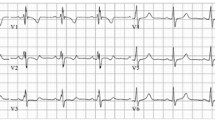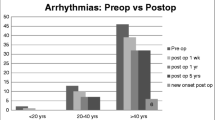Abstract
We investigated the mid-to-long-term results of transcatheter closure of atrial septal defect (ASD) in patients ≥40 years since there are issues with patients presenting with pulmonary hypertension and arrhythmia at the time of closure. In an 8.8 year period, transcatheter closure of ASD was successful in 179 patients aged ≥40 years, but failed in 2. Of the 179 patients (44 males, median 53 years), NYHA functional class, presence of arrhythmia and severity of pulmonary hypertension were compared before and after closure. Patients with pulmonary hypertension (n = 43, 24 %) were significantly older (60 ± 11 vs. 52 ± 9 years, p < 0.01) and required larger devices (27 ± 7 vs. 24 ± 7 mm, p = 0.04) than those without. Arrhythmia before intervention was documented in 31 patients (17.3 %): 22 atrial fibrillation (AF), 4 atrial flutter and 5 supraventricular tachycardia. Patients with AF or atrial flutter (n = 26) were significantly older (63 ± 10 vs. 53 ± 10 years, p = 0.048) and had a higher pulmonary artery mean pressure (29.2 ± 12.6 vs. 20.2 ± 7.6 mmHg, p = 0.041) than those without. The mean follow-up period was 3.8 ± 2.1 years. Early new-onset arrhythmia was documented in 23 patients of whom 1 had persistent AF, 1 developed sick sinus syndrome and others were in sinus rhythm at latest visit. There was significant improvement in NYHA functional class after closure (p < 0.001). Of the 22 patients with AF, 10 were in sinus rhythm, 1 had paroxysmal AF, and 11 had persistent AF. Pulmonary hypertension persisted in 13 patients. Transcatheter closure of atrial septal defect in patients above 40 years is beneficial in terms of NYHA functional class, pulmonary artery pressure and cardiac rhythm.



Similar content being viewed by others
References
Webb G, Gatzoulis MA (2006) Atrial septal defect in the adult: recent progress and overview. Circulation 114:1645–1653
Shah D, Azhar M, Oakley CM, Cleland JG, Nihoyannopoulos P (1994) Natural history of secundum atrial septal defect in adults after medical or surgical treatment, a history prospective study. Br Heart J 71:224–228
Gatzoulis MA, Redington AN, Somerville J, Shore DF (1996) Should atrial septal defects in adults be closed? Ann Thorac Surg 61:657–659
Konstantinides S, Geibel A, Olschewski M, Görnandt L, Roskamm H, Spillner G, Just H, Kasper W (1995) A comparison of surgical and medical therapy for atrial septal defect in adults. N Engl J Med 333:469–473
Murphy JG, Gersh BJ, McGoon MD, Mair DD, Porter CJ, Ilstrup DM, McGoon DC, Puga FJ, Kirklin JW, Danielson GK (1990) Long term outcome after surgical repair of isolated atrial septal defects. Follow-up at 27 to 32 years. N Engl J Med 323:1645–1650
Ward C (1994) Secundum atrial septal defect: routine surgical treatment is not of proven benefit. Br Heart J 71:219–223
Jemielity M, Dyszkiewicz W, Paluszkiewicz L, Perek B, Buczkowski P, Ponizynski A (2001) Do patients over 40 years of age benefit from surgical closure of atrial septal defects? Heart 85:300–303
Attie F, Rosas M, Granados N, Zabal C, Buendia A, Calderon J (2001) Surgical treatment for secundum atrial septal defects in patients >40 years old. J Am Coll Cardiol 38:2035–2042
Du ZD, Hijazi ZM, Kleinman CS, Silverman NH, Larntz K, Investigators Amplatzer (2002) Comparison between transcatheter and surgical closure of secundum atrial septal defect in children and adults: results of a multicenter nonrandomized trial. J Am Coll Cardiol 39:1836–1844
Ueda H, Yanagi S, Nakamura H, Ueno K, Gatayama R, Asou T, Yasui S (2012) Device closure of atrial septal defect: immediate and mid-term results. Circ J 76:1229–1234
Kircher BJ, Himelman RB, Schiller NB (1990) Noninvasive estimation of right atrial pressure from the inspiratory collapse of the inferior vena cava. Am J Cardiol 66:493–496
Engelfriet P, Meijboom F, Boersma E, Tijssen J, Mulder B (2008) Repaired and open atrial septal defects type II in adulthood: an epidemiological study of a large European cohort. Int J Cardiol 126:379–385
Amin Z, Hijazi ZM, Bass JL, Cheatham JP, Hellenbrand WE, Kleinman CS (2004) Erosion of Amplatzer septal occluder device after closure of secundum atrial septal defects: review of registry of complications to minimize future risk. Catheter Cardiovasc Interv 63:496–502
Bruch L, Winkelmann A, Sonntag S, Scherf F, Rux S, Grad MO, Kleber FX (2008) Fenestrated occluders for treatment of ASD in elderly patients with pulmonary hypertension and/or right heart failure. J Interven Cardiol 21:44–49
Gatzoulis MA, Freeman MA, Siu SC, Webb GD, Harris L (1999) Atrial arrhythmia after surgical closure of atrial septal defects in adults. N Engl J Med 340:839–846
Ghosh S, Chatterjee S, Black E, Firmin RK (2002) Surgical closure of atrial septal defects in adults: effect of age at operation on outcome. Heart 88:485–487
Mantovan R, Gatzoulis MA, Pedrocco A, Ius P, Cavallini C, De Leo A, Zecchel R, Calzolari V, Valfrè C, Stritoni P (2003) Supraventricular arrhythmia before and after surgical closure of atrial septal defects: spectrum, prognosis and management. Europace 5:133–138
Berger F, Vogel M, Kramer A, Alexi-Meskishvili V, Weng Y, Lange PE, Hetzer R (1999) Incidence of atrial flutter/fibrillation in adults with atrial septal defect before and after surgery. Ann Thorac Surg 68:75–78
Silversides CK, Siu SC, Mclaughlin PR, Haberer KL, Webb GD, Benson L, Harris L (2004) Symptomatic atrial arrhythmias and transcatheter closure of atrial septal defects in adult patients. Heart 90:1194–1198
Vecht JA, Saso S, Rao C, Dimopoulos K, Grapsa J, Terracciano CM, Peters NS, Nihoyannopoulos P, Holmes E, Gatzoulis MA, Athanasiou T (2010) Atrial septal defect closure is associated with a reduced prevalence of atrial tachyarrhythmia in the short to medium term: a systematic review and meta-analysis. Heart 96:1789–1797
Humenberger M, Rosenhek R, Gabriel H, Rader F, Heger M, Klaar U, Binder T, Probst P, Heinze G, Maurer G, Baumgartner H (2011) Benefit of atrial septal defect closure in adults: impact of age. Eur Heart J 32:553–560
Giardini A, Dorti A, Sciarra F, Bronzetti G, Mariucci E, Picchio FM (2009) Long-term incidence of atrial fibrillation and flutter after transcatheter atrial septal defect closure in adults. Int J Cardiol 134:47–51
Silversides CK, Haberer K, Siu SC, Webb GD, Benson LN, McLaughlin PR, Harris L (2008) Predictors of atrial arrhythmia after device closure of secundum type atrial septal defects in adults. Am J Cardiol 101:683–687
Spies C, Khandewal A, Timmermanns I, Schrader R (2008) Incidence of atrial fibrillation following transcatheter closure of atrial septal defects in adults. Am J Cardiol 102:902–906
Swan L, Varma C, Yip J, Warr M, Webb G, Benson L, McLaughlin P (2006) Transcatheter device closure of atrial septal defect in the elderly: technical considerations and short-term outcomes. Int J Cardiol 107:207–210
Majunke N, Bialkowski J, Wilson N, Szkutnik M, Kusa J, Baranowski A, Heinisch C, Ostermayer S, Wunderlich N, Sievert H (2009) Closure of atrial septal defect with the Amplatzer septal occluder in adults. Am J Cardiol 103:550–554
Roos-Hesselink JW, Meijboom FJ, Spitaels SE, van Domburg R, van Rijen EH, Utens EM, Bogers AJ, Simoons ML (2003) Excellent survival and low incidence of arrhythmias, stroke and heart failure long-term after surgical ASD closure at young age. Eur Heart J 24:190–197
Wi J, Choi JY, Shim JM, Uhm JS, Hwang HJ, Kim JY, Pak HN, Joung B, Lee M (2013) Fate of preoperative atrial fibrillation after correction of atrial septal defect. Circ J 77:109–115
Van De Bruaene A, Delcroix M, Pasquet A, De Backer J, Paelinck B, Morissens M, Budts W (2011) The importance of pulmonary artery pressures on late atrial arrhythmia in transcatheter and surgically closed ASD type secundum. Int J Cardiol 152:192–195
Wagdi P (2010) Incidence and predictors of atrial fibrillation following transcatheter closure of interatrial communications using contemporary device. Clin Res Cardiol 99:507–510
Santoro G, Rascotto M, Sarubbi B, Cappelli Bigazzi M, Calvanese R, Iacono C, Pisacane C, Palladino MT, Pacileo G, Russo MG, Calabrò R (2004) Early electrical and geometric changes after percutaneous closure of large atrial septal defect. Am J Cardiol 93:876–880
Kort HW, Balzer DT, Johnson MC (2001) Resolution of right heart enlargement after closure of secundum ASD with transcatheter technique. J Am Coll Cardiol 38:1528–1532
Jategaonkar S, Scholtz W, Schmidt H, Horstkotte D (2009) Percutaneous closure of atrial septal defects: echocardiographic and functional results in patients older than 60 years. Circ Cardiovasc Interv 2:85–89
Patel A, Lopez K, Banerjee A, Joseph A, Cao QL, Hijazi ZM (2007) Transcatheter closure of atrial septal defect in adults ≥ 40 years of age: immediate and follow-up results. J Interven Cardiol 20:82–88
Khan AA, Tan JL, Li W, Dimopoulos K, Spence MS, Chow P, Mullen MJ (2010) The impact of transcatheter atrial septal defect closure in the old population. JACC Cardiovasc Interv 3:276–281
Brochu MC, Baril JF, Dore A, Juneau M, De Guise P, Mercier LA (2002) Improvement in exercise capacity in asymptomatic adults after atrial septal defect percutaneous closure. Circulation 106:1821–1826
Yong G, Khairy P, De Guise P, Dore A, Marcotte F, Mercier LA, Noble S, Ibrahim R (2009) Pulmonary arterial hypertension in patients with transcatheter closure of secundum atrial septal defects: a longitudinal study. Circ Cardiovasc Interv 2:455–462
Huang ZW, Fan ZX, Sun JT, Lin WM, Gao YQ, Quan YH, Geng YM, Niu YY, Wu BX (2012) The short-and medium-term results of transcathetrer closure of atrial septal defect and severe pulmonary arterial hypertension. Heart Vessels 27:603–609
de Lezo JS, Medina A, Romero M, Pan M, Segura J, Caballero E, Pavlovic D, Ortega JR, Franco M, Delgado A, Ojeda S, Mesa D, Lafuente M (2002) Effectiveness of percutaneous device occlusion for atrial septal defect in adult patients with pulmonary hypertension. Am Heart J 144:877–880
Taniguchi Y, Emoto N, Miyagawa K, Nakyama K, Kimutani H, Tanaka H, Shinke T, Okada K, Okita Y, Hirata K (2014) Subsequent shunt closure after targeted medical therapy can be an effective strategy for secundum atrial septal defect with severe pulmonary artery hypertension: two case reports. Heart Vessels 29:282–285
Acknowledgments
This study was supported by a grant from National Science Council, Taiwan, ROC. Grant No. 101-2314-B-002-143-MY3.
Author information
Authors and Affiliations
Corresponding author
Ethics declarations
Conflict of interest
No conflicts of interest.
Rights and permissions
About this article
Cite this article
Wang, JK., Chiu, SN., Lin, MT. et al. Mid-to-long-term follow-up results of transcatheter closure of atrial septal defect in patients older than 40 years. Heart Vessels 32, 467–473 (2017). https://doi.org/10.1007/s00380-016-0886-y
Received:
Accepted:
Published:
Issue Date:
DOI: https://doi.org/10.1007/s00380-016-0886-y




